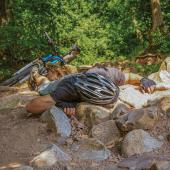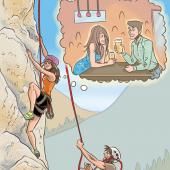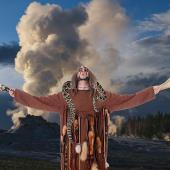Poised to Pull
Improving mechanics & preventing injury.
As climbers, we are all looking for ways to make gains in strength and performance. By spring, the clock is ticking to make those gains training, prior to testing ourselves on real rock. Accurate self-assessment of current strength, power, endurance, head game, and health can help tailor training to make those summer outings more enjoyable and productive.
These days, many climbers I meet are dedicating a lot of time to training. While many are doing so in a very structured way, it is difficult to self-assess asymmetries in one’s body that current training may be exacerbating. Even for the novice climber, asymmetries in strength and mobility can really impact not only performance, but also risk of injury.
I have had the unique opportunity over the past five years to tailor my practice as a physical therapist. One of my goals dating back to grad school was to create a system of movement analysis for climbers to help optimize injury prevention and training programs. Last fall, this dream was realized when we opened the Climbing Lab at Excel Physical Therapy.
The Climbing Lab is a movement analysis lab for climbers. Our bouldering wall is a systems climbing wall, meaning it has a symmetrical layout, with a built-in LED system to guide the climber’s path through a variety of mirrored movement patterns tailored to his or her ability. This provides a means to compare movements on one side versus the other, to tease out asymmetries in mobility and strength. The movements are captured on video and through slow-motion analysis, reveal asymmetries in joint angles, areas of strength and weakness, and areas for technique improvement.
Reviewing climbers’ biomechanics from the lab reveal a few key areas of compensation. By far the most common area for injury in climbers is the upper extremity, and this is often rooted in poor shoulder poise. Think of shoulder poise as more than just posture; it’s the conscious control and activation of key shoulder muscles to optimize stability. Shoulder poise not only reduces stresses on the shoulder and other joints in the upper extremity, but it is also vital to generating power.
Regardless of your ability level and preferred style, you can get stronger and more powerful by climbing with poise. Optimizing poise facilitates activation and strengthening of these key muscles and, in turn, gets you more out of your training time and plastic pulling.
To accomplish this, you must understand three key errors in shoulder mechanics. The first is excessive protraction, or letting your shoulder blade flare out laterally from your spine, implying decreased activation of key scapular muscles. The second is excessive elevation of the shoulder blade, which indicates impaired lower trapezius activation and strength. Finally, excessive glenohumeral joint internal rotation, observed as winging out and back with the elbow, indicates an inhibition or weakness in the rotator cuff.
Asymmetries are habits, movement schemas that we are often unaware of. Climbing with asymmetries and impairments in muscle activation perpetuate and exacerbate the asymmetries. Time and again in the lab, climbers realize these impairments through the inability to perform a certain movement on one side while having no problem performing the inverse movement. Strengthening these areas is the easy part; it is more difficult to integrate conscious control of the shoulder while you’re climbing and in all aspects of training.
Conscious control should consist of the following: with each hold you reach for, feel your lower scapular muscles activate by actively pulling your scapula down and in toward your spine. As you weight your grip more heavily, keep those muscles activated, resisting protraction and elevation of the scapula. As you move from a straight elbow to a bent elbow, keep these muscles engaged and fight the urge to wing your elbows out, feeling the back of the shoulder activate to keep your elbow in the line of the body. Finally, always be mindful of the shoulder blade elevating, as this is both a weaker and a more vulnerable shoulder posture. Attention to these training details can be the difference between a successful summer, and a season-ending injury.
Matt Heyliger is a physical therapist at Excel Physical Therapy with a specialty in climbing.










